|

                   
The canal, the old town
and a modern city on the rise...
|
|
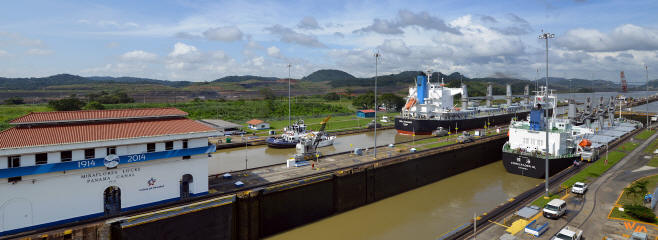
Two full-size cargo ships heading north rising at
different levels in the Panama Canal Miraflores locks |
A planned end-of-year mileage run combined with a sales
call in Wayne, NJ that fell through landed me in New
York City for one day and then on to a Central America
jaunt through Panama. Having never been there before,
Panama was a pleasant surprise, combining interesting
sights, the iconic and expanding canal and a snapshot of
a rising third world capital.
|
|
|
Tuesday & Wednesday, December 3rd & 4th - New York City
I arrived at Newark from LA just after 5pm on Tuesday and made
a beeline to the
Airtrain, connecting to NJ Transit for the quick ride into
Penn Station in midtown Manhattan. I walked from Penn Station
to Times Square and got in line at the half-price ticket booth
in plenty of time to get a ticket for
Spiderman - Turn Off The Dark that evening. After checking
in (on points) at the
Marriott Marquis, I grabbed a quick snack in the lounge
and headed for the Foxwoods Theatre.
I had a half-day to spend in New York City on Wednesday before
my Panama flight, so I did some walking around Times Square
(first picture below) and Rockefeller Center and took in two
museums, the
International Center for Photography and the
MOMA
(second picture below).
|
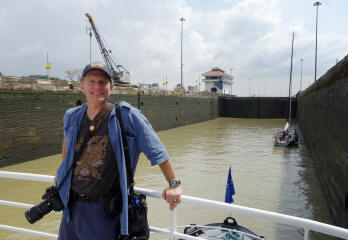
Heading 30 feet down in the Pedro Miguel canal locks |
|
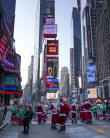
Times Sq. Santas |
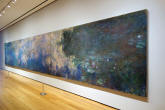
NYC MOMA water lilies |
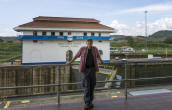
Miraflores locks visitor center |
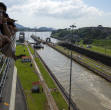
Miraflores balcony |
|
Thursday December 5th - Panama Canal Miraflores locks &
Casco Viejo, the old city
After my late arrival from Newark on Wednesday night I woke around
8am, grabbed breakfast in the lounge and walked the half mile
or so to the
Multicentro complex where I bought a
Hop-On-Hop-Off ($29) bus ticket for the day. Having read
about difficulties with the unmetered taxis in Panama City,
coupled with my complete lack of Spanish language skills, I
decided to use the Hop-On-Off bus routine to see a couple of
the major sites and get my bearings on my first day. The
strategy was somewhat successful, but a lot of time was wasted
waiting for the next bus after my sightseeing was done. My
first Hop-Off was at the
Miraflores Locks Visitor Center near the southern end of the
Panama Canal. The Visitors Center was cheap ($5) and very well
organized with excellent views from all four levels (third and
fourth pictures above). A live, running information commentary
in English and Spanish on the canal's history and it's current
expansion along with real-time ship traffic updates could be
heard throughout the complex.
My next Hop-Off was at Casco Viejo, the old city of Panama -
more accurately the second old city of Panama, pre-dated by
the 300 year older Panama Viejo area to the east of the city
center that was sacked by the pirate Captain Henry Morgan in
1671.
Casco Viejo is described in guide books as half crumbling,
half high-end, which, based on my visit is too generous on the high-end side. Armed with a local map, I did a worthwhile 90 minute circular walk around and
through the area with its narrow streets (first picture
below), colonial period buildings (second picture below) and town squares
anchored by cathedrals (third picture below). Most of the churches and
buildings were closed, the exceptions being the ones under
restoration (fourth picture below). There was a lack of decent
restaurants open, likely because I was there at a weird dining
time, mid-afternoon. The visit felt safe with a visible
tourist police presence, but the area was edgy enough that I would not feel
comfortable walking those same streets alone at night.
Completing my Panama City tourist loop for the day, I returned
to Multicentro on the Hop-On-Hop-Off bus while experiencing Panama City's world class bad rush hour traffic,
made worse by the construction of their metro system and a
significant building boom.
Realizing that I hadn't eaten since breakfast, I was all set
to park for an early dinner at the Hard Rock Cafe, only to
discover that the Hard Rock Hotel at Multicentro had recently
closed its cafe. I decided instead to walk back to my hotel
with a stop at the Rey Supermarket for a good bottle of Rioja
and some snacks and then
finished my first day in Panama with a light dinner at the hotel's
concierge
lounge.
|
|
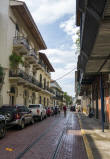
Casco Viejo street |
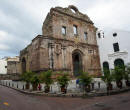
Convent Santo Domingo |
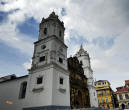
Iglesia Cathedral |
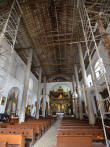
Iglesia Merced |
|
Friday December 6th - Panama Canal transit, Gamboa south to
the Causeway
A quick overview of the Panama Canal - The canal was built a
hundred years ago by the US to allow cargo and passenger
traffic between the Pacific and Atlantic oceans without having
to sail all the way around South America through the Straights
of Magellan. The French had tried and failed at a "lockless"
approach before the US. Their failure was more due to
mosquito-driven yellow fever than their engineering approach.
In the existing canal, there are a total of six "locks" that
raise or lower ships from sea level on either end of the canal
(the Pacific and Atlantic oceans are at the same level) to the
higher lake level in order to traverse the middle of the
country. The locks work on gravity, using directed lake water
to fill the locks and then releasing it toward the ocean to
lower the ships down. The Gatun locks on the Atlantic side is
a three lock system, the Pedro Miguel lock is a single step
followed by the double step Miraflores locks on the Pacific side (large
picture top of page left). All of the locks are two lanes wide
and accommodate the same maximum size ship, dubbed "panamax".
I had done research ahead of my trip to select and book a
southbound partial canal transit for Friday. I taxied 30
minutes from my hotel to the end of
the Amador Causeway where I
checked in with
Panama Marine Adventures around 9am and took the 40 minute bus ride
to Gamboa, which is about halfway across the country at the
northern end of the narrow Gaillard Cut. There I boarded the
Pacific Queen for my half-day canal transit. After sailing
through the continental divide (first picture below) at its
only break anywhere in North or South America and then under
the Centennial bridge we entered the first lock on the
Pacific side of the canal, Pedro Miguel (large picture top of
page right), which lowered us 9 meters toward sea level in one
step (second picture below at lake level & third picture below
9 meters lower in the same spot). Continuing
across the man-made Miraflores Lake, we entered the upper lock
at Miraflores (fourth picture below).
|
|
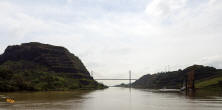
Centennial bridge at continental divide |
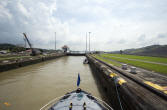
Entering Pedro Miguel lock |
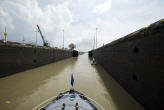
Exiting Pedro Miguel lock |
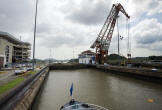
Miraflores upper lock |
|
Our tiny boat (first picture below) was dwarfed by the size of
the massive locks at Miraflores, built stronger than other
locks to withstand direct Pacific currents. The Miraflores
locks lowered us the remaining 18 meters in two successive
steps to sea level (second picture below). Continuing to the
end of the canal we passed under the
Bridge of the Americas (third picture below), which marks
the beginning of the
Pan American Highway north all the way to Alaska. We looped
around the man-made Amador Causeway (fourth picture below) on our
approach to the dock. After walking around the Flamenco
Marina, I hailed a taxi and returned to my hotel just ahead of
a rainstorm. The rain kept coming, so I opted for a quiet
dinner in the hotel's bar while I sorted and post-processed my
shots from my first two days in Panama.
|
|
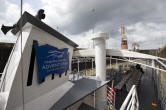
Pacific Queen in lower lock |
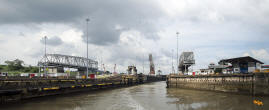
Leaving Miraflores locks at sea level |
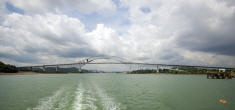
Bridge of the Americas over the canal |
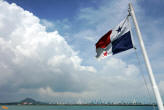
Flag, causeway & skyline |
|
Saturday December 7th - Panama City Cinta Costera urban
park
For my last full day in Panama I decided to sleep in and then
do a "walkabout" along the relatively new Cinta Costera urban
park that hugs the crescent-shaped Pacific coast of Panama
City. The park is completely commercial-free and well
maintained. Starting at the pedestrian overpass closest to my
hotel (first picture below taken from there) I walked south
past outdoor art (second picture below) and through expansive
park settings (third and fourth pictures below) to the edge of
Casco Viejo. The park walk totaled 7KM round trip according to
the markers along the way. Adding the inland walk to and from
my hotel, my walkabout was roughly 5 miles long. That may not
sound like a lot, but the afternoon weather was 95°F with
nearly 100% humidity. For my last dinner in Panama I walked
north about a half mile from my hotel to the
Wine Bar, an inexpensive Italian restaurant with an
extensive wine-by-the-glass selection having great potential
that was overshadowed by painfully slow service.
|
|
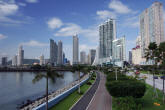
Cinta Costera urban park |
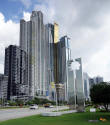
Cinta Costera art |
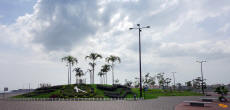
Flower clock - Casco Viejo backdrop |
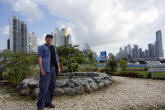
Cinta Costera park bridge |
|
Some
final observations from my short visit to Panama: Panama is an easy place for an American to visit. US dollars are not only
accepted here – they are the actual currency of the country.
My lack of language skills was a barrier – more so than in
Europe or Asia, but the people I communicated with were friendly and
understanding. My almost real-time Android phone
Spanish/English translator -
Jibbigo, was
helpful in a couple of spots and was also a hit as far as entertainment value.
Panama City has world class bad traffic – I’d put it somewhere
between Bangkok and Cairo from my limited experience. It makes
the 405 at rush hour in LA look like wide-open spaces. Part of
the reason for the traffic is that they are installing a
subway system to help fix the problem. Coupled with rapid
growth due to a pro-business government, the downtown streets
come to a complete standstill sometimes that the traffic cops
have to sort out one car at a time. There’s a palpable air of
optimism in the people that I met. There are some ugly looking
slums on the outskirts of town and things are third-world bad
in many ways, but things are also getting better fast. The new
canal being dug now is massive and will bring a bunch of new
money in once it opens, allowing significantly bigger ships through the
locks. Meanwhile, digging it has brought unemployment to near
zero. I didn't see a single homeless or mentally ill person on the streets
during my entire visit. The food was generally good and I cultivated my
appetite for ceviche paired with Spanish wine that started
back when I was in Peru a few
years back. All-in-all Panama was a good place to
experience, at least this once. I returned to LA via Houston
on Sunday morning. |

                   
Mackey Group, Inc.
© 2002 - 2014
|
|